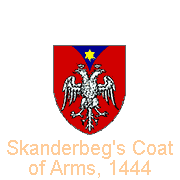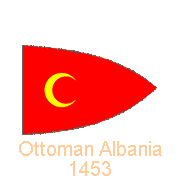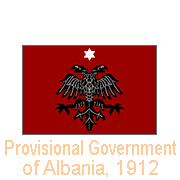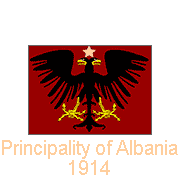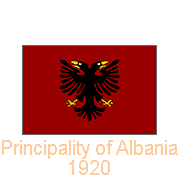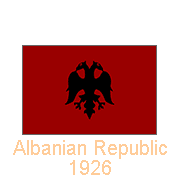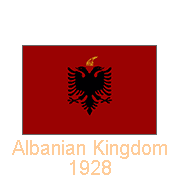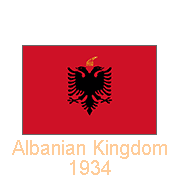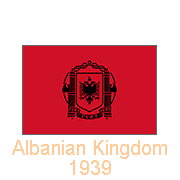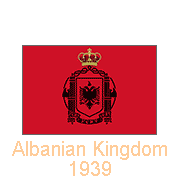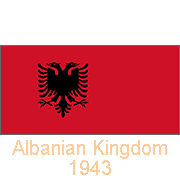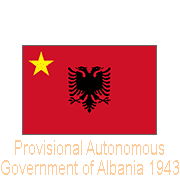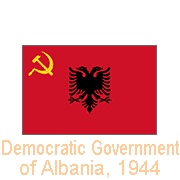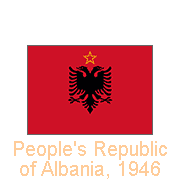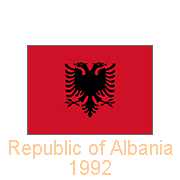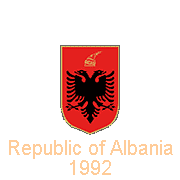Flags from Albania
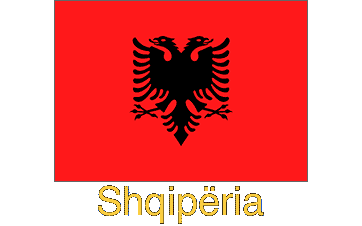
A Flag history of Albania
The origin of the Albanian flag, a red field with a Byzantine double-headed eagle, is supposed to go back to the medieval Albanian hero Skanderbeg (Gjergj Kastriot Skënderbeu). He fought against the Turks in the late 15th Century under the double-headed eagle flag, “Flamur e Skënderbeut”. In the 19th Century, the Albanian independentist circles opposed to Ottoman rule again used this flag, which never was forgotten.
you may then send it as a postcard if you wish.
The flag was used by the Albanian chief Isa Boletin in 1910 when he rebelled against Turkey. An autonomous government was proclaimed in June 1911, and a red flag with the black double-headed eagle was raised in Prishtina (now in Kosovo). A few weeks later, the flag was flying all over Southern Albania as well. In May 1912, the Albanians took Üsküb (now Skopje, North Macedonia), and Turkey recognised the autonomy of Albania in June 1912. During the First Balkan War, on 28 November 1912, Ismail Qemali declared Albania’s independence in Vlora and raised a flag with the black eagle of Skanderbeg on a red field. The Provisional Government of Albania was created by the Assembly of Vlora on 4 December 1912. A white six-pointed star was added to the flag, symbolising the unity between Catholics, Orthodox and Muslims.
After the Second Balkan War in 1913, Serbia, Montenegro, and Greece split Albania among them. But on 29 July 1913, at a conference in London, the then six great powers proclaimed Albania’s independence as a Principality under Wilhelm Von Wied, a German prince. He landed in Durrës on 7 March 1913 but left six months later as he lacked international support and faced a revolt by the Muslims in central Albania. The flag used had a redrawn double-headed eagle, now with a yellow beak and talons, and a white five-pointed star.
During the First World War, various armies occupied the country. In 1920, when the Italians had finally left, a Congress in Lushnja proclaimed a new government. On 17 July 1924, Fan Noli, an Orthodox priest, who had lived in the USA, became Prime Minister and Regent. Earlier that year, Ahmet Bey Zogu, a chieftain from the north who previously had served as Minister of the Interior and Prime Minister, had been forced to flee the country. He came back with financial help from Yugoslavia and Britain in December the same year and overthrew Fan Noli’s government. In 1925 a republic was proclaimed with Ahmet Zogu as President; the flag changed to a simpler design. Three years later, Zogu declared the country a monarchy, with himself as King Zog I. The flag was again redesigned and now had Skanderbeg’s helmet added to the double-headed eagle. The flag’s field was a very dark red until 1934, when a much lighter shade was adopted. Under Zog’s rule, Albania allied itself with Mussolini’s Italy.
On 7 April 1939, Albania was invaded by the Italians, who had King Zog I deposed and replaced by the Italian king, Vittorio Emmanuele III. The flag now had Fascist symbols added: two black fasces, connected above by two Savoy ribbons in black, and below by a black scroll with the motto of the House of Savoia: “FERT” (Foedere Et Religione Tenemur, Latin for “We are held together by Pact and Religion”). After Italy surrendered to the Allies in 1943, German troops occupied the country. On 20 October 1943, the monarchical Constitution of 1 October 1928 was re-established by the National Assembly. Though militarily controlled by the Germans, the Albanians retained autonomy in internal affairs and refused to hand over the Jewish residents and refugees.
Meanwhile, Enver Hoxha, whose communist partisans had been fighting the fascists, constituted a provisional autonomous government for the liberated zones. They adopted the flag used before the Italian occupation, with a yellow star placed in the canton. The Germans withdrew from Albania in the fall of 1944, and on 10 October 1944, Enver Hoxha proclaimed the constitution of the Democratic Government of Albania as a provisional government. Although the flags with the yellow star continued to be used, other flags emerged with a hammer and sickle, the emblem of the Albanian Communist Party that had led the liberation struggle. In the liberation festivities held in Tirana on 29 November 1944, the national flag was flown without a star or hammer and sickle.
In elections held on 2 December 1945, 80% voted for the National Democratic Front coalition led by the Communists. On 11 January 1946, King Zog I was declared deposed, and the People’s Republic of Albania was proclaimed. On 7 March 1946, a Constitution came into effect, which established a new national flag with a yellow-bordered red star placed above the double-headed eagle. In 1976 a new Constitution was adopted, and the state’s name changed to “People’s Socialist Republic of Albania”, but the flag stayed the same. In 1992 Communist rule ended: the communist star was removed from the national flag on 7 April 1992. Once more, Albania flew the “Flamur e Skënderbeut” (Skanderbeg’s flag), a red field with a black double-headed eagle.


